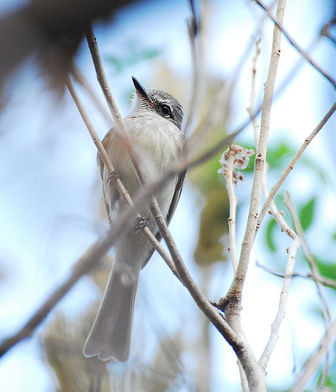Flammulated Flycatcher
The species was first described in 1875 by ornithologist George Newbold Lawrence, who placed this species in the genus Myiarchus. However, in 1893 it was split from Myiarchus into the new, monotypic genus Deltarhynchus by Robert Ridgway because of its shorter and broader bill, more rounded wings, and partially streaked underparts.

Original source: Jerry OldenettelPermission(Reusing this file)This image, which was originally posted to Flickr.com, was uploaded to Commons using Flickr upload bot on 23:18, 13 April 2008 (UTC) by Ltshears (talk). On that date it was licensed under the license below. This file is licensed under the Creative Commons Attribution-Share Alike 2.0 Generic license.You are free:to share – to copy, distribute and transmit the work
Author: Jerry OldenettelPermission(Reusing this file)This image, which was originally posted to Flickr.com, was uploaded to Commons using Flickr upload bot on 23:18, 13 April 2008 (UTC) by Ltshears (talk). On that date it was licensed under the license below. This file is licensed under the Creative Commons Attribution-Share Alike 2.0 Generic license.You are free:to share – to copy, distribute and transmit the work
The Flammulated Flycatcher is classified as Least Concern. Does not qualify for a more at risk category. Widespread and abundant taxa are included in this category.
Flammulated Flycatcher has a discontin- uous distribution in dry deciduous woodlands along the Pacific coast of Mxico, from south- ern Sinaloa to Chiapas (Miller et al. 1957). Many of the localities where the species has been observed or collected may be character- ized as open, thom woodland, dominated by mesquite (Prosopis spp.) and acacia (Acacia spp.), but this flycatcher strangely is not com- mon in nor invariably associated with this typ- ical, widely occurring Pacific coastal habitat. More
The Flammulated Flycatcher, Deltarhynchus flammulatus, is a species of bird in the Tyrannidae family and is the only species in the monotypic genus Deltarhynchus, although it is closely related to the birds of the genus Myiarchus. It is endemic to the dry deciduous forest, arid thorn forest, and scrubby woodland of Mexico’s Pacific coast. The flycatcher is an olive to gray-brown bird with a streaked, pale gray chest, white throat, black bill, dark gray feet, and dark brown wings. More
A song phrase of Flammulated Flycatcher recorded in Jalisco, Mexico. Sound analysis and wave file More
like Red-breasted Chat and Flammulated Flycatcher, makes for a truly wonderful tour. The excellent food, comfortable accommodations, and relaxed stay at a single location cap off the great birding to make for a superb overall tour. Birding the thorn forest, an area high in endemic birds, is a highlight of any trip to this part of Mexico. Our trip to Tehua produced no fewer than 14 endemics, including Happy and Sinaloa wrens, Citreoline Trogon, Blue Mockingbird, and Golden-cheeked Woodpecker. More
Flammulated Flycatcher was easily taped out at the bend at km 11; Belted Flycatcher was finally found – after much trawling with the iPod –a few hundred metres beyond the third mirador (El Roblar), where there is a left hand bend in the road and some bamboo just after it. It was perched in the bamboo and didn’t vocally respond so would be easy to overlook. More
Wren, and, if we are lucky, Flammulated Flycatcher, in addition to a diversity of other migratory and residents. We'll make our way to a solitary and beautiful beach for a picnic lunch. If time permits we'll also bird the marshes on the road to the Manzanillo Airport. Approximate time from departure to arrival: 8-9 hours Includes: Insurance, birding interpretation, binoculars, picnic lunch. More
Family : Tyrannidae
Genus : Deltarhynchus
Species : flammulatus
Authority : (Lawrence, 1875)
